Gallery of "Book" builds
- Trevor Gore
- Blackwood
- Posts: 1629
- Joined: Mon Jun 20, 2011 8:11 pm
Gallery of "Book" builds
Numerous people have written to me about the guitars they have built using ideas from the books, liberally interspersed with ideas of their own. These guitars really do capture the essence of what Gerard and I were wanting to encourage when we wrote the books: a guitar design and build methodology that would enable people to bring their own ideas to fruition.
I'll start by posting some of the pictures that have been sent to me (having obtained permission) but I would like to encourage anyone who has found the books useful to post pictures (maybe 3 or so per instrument) with a brief description of what you were attempting and how you thought it went. Any "applause" from the audience will be greatly appreciated!
First cab off the rank is a guitar by Leonhard Augenstein from Germany. It's his number 8, mostly built prior to his getting the books, followed by some more recent instruments which illustrate how his ideas developed.
Enjoy!
I'll start by posting some of the pictures that have been sent to me (having obtained permission) but I would like to encourage anyone who has found the books useful to post pictures (maybe 3 or so per instrument) with a brief description of what you were attempting and how you thought it went. Any "applause" from the audience will be greatly appreciated!
First cab off the rank is a guitar by Leonhard Augenstein from Germany. It's his number 8, mostly built prior to his getting the books, followed by some more recent instruments which illustrate how his ideas developed.
Enjoy!
Fine classical and steel string guitars
Trevor Gore, Luthier. Australian hand made acoustic guitars, classical guitars; custom guitar design and build; guitar design instruction.
Trevor Gore, Luthier. Australian hand made acoustic guitars, classical guitars; custom guitar design and build; guitar design instruction.
- Trevor Gore
- Blackwood
- Posts: 1629
- Joined: Mon Jun 20, 2011 8:11 pm
Leonhard Augenstein #8
"I have finished my latest guitar (number 8 ) some days ago and would like to share some photos with you....
The sound of the guitar is pretty good and now I want to try another one with consideration of what I am learning from your fantastic guitar books...."
The sound of the guitar is pretty good and now I want to try another one with consideration of what I am learning from your fantastic guitar books...."
Fine classical and steel string guitars
Trevor Gore, Luthier. Australian hand made acoustic guitars, classical guitars; custom guitar design and build; guitar design instruction.
Trevor Gore, Luthier. Australian hand made acoustic guitars, classical guitars; custom guitar design and build; guitar design instruction.
- Trevor Gore
- Blackwood
- Posts: 1629
- Joined: Mon Jun 20, 2011 8:11 pm
Leonhard Augenstein "Die Nächste" (The next)
"It took me a bit longer to finish that guitar 'cause a heavy cold knocked me out for some weeks.
The new bridge design is doing a very good job on this guitar and before I glued it on the body I compared the weight of it with a traditional Martin bridge. To my surprise my bridge is 10 gramms lighter than the Martin bridge.
Again I get a very even sound. Basses, mid tones and heights are very strong, but nicely balanced.
The body design is my very own design with straight sloped shoulders. This allows some more access to the 15th and 16th fret without having a cutaway".
The new bridge design is doing a very good job on this guitar and before I glued it on the body I compared the weight of it with a traditional Martin bridge. To my surprise my bridge is 10 gramms lighter than the Martin bridge.
Again I get a very even sound. Basses, mid tones and heights are very strong, but nicely balanced.
The body design is my very own design with straight sloped shoulders. This allows some more access to the 15th and 16th fret without having a cutaway".
Fine classical and steel string guitars
Trevor Gore, Luthier. Australian hand made acoustic guitars, classical guitars; custom guitar design and build; guitar design instruction.
Trevor Gore, Luthier. Australian hand made acoustic guitars, classical guitars; custom guitar design and build; guitar design instruction.
- Trevor Gore
- Blackwood
- Posts: 1629
- Joined: Mon Jun 20, 2011 8:11 pm
Leonhard Augenstein #11
"I have just finished a sloped shoulder dreadnaught, following your building plan from your book. But instead of the traditional bridge I use my own bridge design.
And the result in sound is just exciting! What a great tone! Loud, balanced, just great. And as you can see, it also looks pretty unique."
And the result in sound is just exciting! What a great tone! Loud, balanced, just great. And as you can see, it also looks pretty unique."
Fine classical and steel string guitars
Trevor Gore, Luthier. Australian hand made acoustic guitars, classical guitars; custom guitar design and build; guitar design instruction.
Trevor Gore, Luthier. Australian hand made acoustic guitars, classical guitars; custom guitar design and build; guitar design instruction.
- Trevor Gore
- Blackwood
- Posts: 1629
- Joined: Mon Jun 20, 2011 8:11 pm
Re: Gallery of "Book" builds
Some outstanding guitars there, Leonhard! Very well done! 
Fine classical and steel string guitars
Trevor Gore, Luthier. Australian hand made acoustic guitars, classical guitars; custom guitar design and build; guitar design instruction.
Trevor Gore, Luthier. Australian hand made acoustic guitars, classical guitars; custom guitar design and build; guitar design instruction.
-
Jason Rodgers
- Gidgee
- Posts: 6
- Joined: Fri Sep 28, 2012 12:00 pm
Re: Gallery of "Book" builds
Very interesting bridge design. Sort of a visual extension of the fingerboard, but apparently still within the weight and glue footprint requirements of traditional shapes. Cool stuff there.
Trevor, your use of this guy's instruments as an example brings up a question: if you promote the idea of your books providing a foundation for construction within an overall personal design aesthetic, what concepts do you see as most essential to stay true to your construction theories? I don't own the books, yet, but my understanding from reading yours and others' posts on the various forums tells me it's very much a "system" approach. But what components of that system can work piecemeal (or can they)? In other words, on a spectrum of, for example, the use of only live-braced backs on one end, to a full-blown book build on the other, where do you see the line drawn to say, "Yes, the G&G system is present and working"?
Trevor, your use of this guy's instruments as an example brings up a question: if you promote the idea of your books providing a foundation for construction within an overall personal design aesthetic, what concepts do you see as most essential to stay true to your construction theories? I don't own the books, yet, but my understanding from reading yours and others' posts on the various forums tells me it's very much a "system" approach. But what components of that system can work piecemeal (or can they)? In other words, on a spectrum of, for example, the use of only live-braced backs on one end, to a full-blown book build on the other, where do you see the line drawn to say, "Yes, the G&G system is present and working"?
- Nick Royle
- Wandoo
- Posts: 16
- Joined: Sun Oct 06, 2013 1:34 am
- Location: London, England
Re: Gallery of "Book" builds
Leonhard, The bridge design is great! First "new" thing I've seen on guitars for a while (I'm guessing it must have some antecedent I don't know of). I love the way it seems to be an extension of the fingerboard. Great aesthetics all 'round!
Very impressive number 8. Congratulations!
That's the thing I love most about "the book", that it isn't about showing only one way to do things. It's about preparing you for coming up with your own ways of doing things. (Not that I'm quite there yet but my next guitar will be using a bunch of things I learned from Trevor and Gerard.)
Very impressive number 8. Congratulations!
That's the thing I love most about "the book", that it isn't about showing only one way to do things. It's about preparing you for coming up with your own ways of doing things. (Not that I'm quite there yet but my next guitar will be using a bunch of things I learned from Trevor and Gerard.)
- Trevor Gore
- Blackwood
- Posts: 1629
- Joined: Mon Jun 20, 2011 8:11 pm
Re: Gallery of "Book" builds
I'll try to keep this short, as this thread is primarily a gallery thread.Jason Rodgers wrote:...what concepts do you see as most essential to stay true to your construction theories?
It's not really about the construction; it's about the design, which starts with an understanding of how a guitar works, how a string vibrates, how that drives the soundboard and how the guitar vibrates to radiate sound and then how to keep all that together in a structure we call a guitar. Without an understanding of how the things works, it's difficult to build an improved version or even consistent versions. With an understanding of how the thing works and what is important, numerous techniques and styles can be usefully implemented, whilst staying within the bounds of the physics that governs a guitar's operation. The key design concepts include monopole mobility, coupling, modal tuning and playing accurately in tune to the equally tempered scale. The build concepts (which provide one method of consistent implementation) are outside moulds, radius dishes, go-bar decks and bolt-on necks.
Leonhard's bridge design is an inspired implementation of an idea put forward by Prof. Jurgen Meyer of Germany back in the 80's, a work I reference, though with a more conventional implementation than Leonhard's. Whether or not Meyer is where Leonhard got his inspiration from, only he can say.
Fine classical and steel string guitars
Trevor Gore, Luthier. Australian hand made acoustic guitars, classical guitars; custom guitar design and build; guitar design instruction.
Trevor Gore, Luthier. Australian hand made acoustic guitars, classical guitars; custom guitar design and build; guitar design instruction.
-
Jason Rodgers
- Gidgee
- Posts: 6
- Joined: Fri Sep 28, 2012 12:00 pm
Re: Gallery of "Book" builds
Boom. Two books into two sentences. The respect meter just hit the ceiling. Thank you!Trevor Gore wrote: The key design concepts include monopole mobility, coupling, modal tuning and playing accurately in tune to the equally tempered scale. The build concepts (which provide one method of consistent implementation) are outside moulds, radius dishes, go-bar decks and bolt-on necks.
Re: Gallery of "Book" builds
Wow there is some great stuff going on here, what fantastic builds and i reckon any teacher would be proud to provide the sort of inspiration that culminated in any of those instruments above.
Steve
Steve
Re: Gallery of "Book" builds
Double post apologies
Re: Gallery of "Book" builds
First of all, thanks a lot all your positive and encouraging comments.
As Trevor Gore already stated very clear, his books are not made and intended to follow them step by step. I can confirm from my side that I did not intend to do so. His great books, specially the design and build book, are much more to me: they are an endless source of inspiration for solving all the little problems that appear when building a guitar. And since I am a self taught guitar maker I have to solve many of that little problems
And to answer the question about the bridge design: No, I was not inspired by anything than the Intention to create something different and to visualise the link between headstock, fretboard, strings and Bridge as a unit. I realised later that this is also improving the guitar sound when done properly. But I had to learn now from Trevor about a German professor for acoustics who had similar thoughts. And this confirms to me that I am on the right way.
Regards,
Leonhard
As Trevor Gore already stated very clear, his books are not made and intended to follow them step by step. I can confirm from my side that I did not intend to do so. His great books, specially the design and build book, are much more to me: they are an endless source of inspiration for solving all the little problems that appear when building a guitar. And since I am a self taught guitar maker I have to solve many of that little problems
And to answer the question about the bridge design: No, I was not inspired by anything than the Intention to create something different and to visualise the link between headstock, fretboard, strings and Bridge as a unit. I realised later that this is also improving the guitar sound when done properly. But I had to learn now from Trevor about a German professor for acoustics who had similar thoughts. And this confirms to me that I am on the right way.
Regards,
Leonhard
- Nick
- Blackwood
- Posts: 3639
- Joined: Thu Feb 26, 2009 11:20 am
- Location: Christchurch, New Zealand
- Contact:
Re: Gallery of "Book" builds
Congratulations Leonhard, some fine looking (and obviously sweet sounding) guitars there & well done Trevor for inspiring them 



 I especially like the first one, some really nice touches with the details (tail end treatment, inlays and rosette)!
I especially like the first one, some really nice touches with the details (tail end treatment, inlays and rosette)!
"Jesus Loves You."
Nice to hear in church but not in a Mexican prison.
Nice to hear in church but not in a Mexican prison.
- DarwinStrings
- Blackwood
- Posts: 1877
- Joined: Thu Nov 13, 2008 10:27 pm
- Location: Darwin
Re: Gallery of "Book" builds
Nice look Leonhard.
"Rose Cliche"
My second guitar since buying the books (9th guitar). My first live back guitar so I was trying to achieve that and get a grip on modal tuning. Very happy with the build especially getting the T(1,1)1, T(1,1)2 and T(1,1)3 into the suggested relationships and in between scale notes. Also very happy with the sound of the guitar though I also know from building it that I have room for improvement, so on to the next happy in the knowledge that I am getting some control.
Jim
"Rose Cliche"
My second guitar since buying the books (9th guitar). My first live back guitar so I was trying to achieve that and get a grip on modal tuning. Very happy with the build especially getting the T(1,1)1, T(1,1)2 and T(1,1)3 into the suggested relationships and in between scale notes. Also very happy with the sound of the guitar though I also know from building it that I have room for improvement, so on to the next happy in the knowledge that I am getting some control.
Jim
Life is good when you are amongst the wood.
Jim Schofield
Jim Schofield
- woodrat
- Blackwood
- Posts: 1154
- Joined: Tue Nov 25, 2008 6:31 am
- Location: Hastings River, NSW.
- Contact:
Re: Gallery of "Book" builds
Hi All, I have just finished this guitar for a customer called Adrian so it is called Adrian's Baritone. It is a 13 fret Mahogany and Cedar Falcate with a sound port. It is the first baritone that I have made and I was pleasantly surprised with the lush sound that emanates from it. It is a 27 inch scale tuned to BEADF#B. The strings are massive bits of wire when compared to normal 12-53 guitar strings.
This guitar started out as a Sitka and Mahogany Dread that I built long before I read "the book" and I was never quite happy with the sound of it....So I used that as the basis for this build...a retop and a new neck later and here it is...
This guitar started out as a Sitka and Mahogany Dread that I built long before I read "the book" and I was never quite happy with the sound of it....So I used that as the basis for this build...a retop and a new neck later and here it is...
"It's never too late to be what you might have been " - George Eliot
Re: Gallery of "Book" builds
Woodrat,
that is a very interesting way to re-do a not so good guitar.
And the result of this work looks interesting as well.
Did you also replace the back bracing?
Regards,
Leonhard
that is a very interesting way to re-do a not so good guitar.
And the result of this work looks interesting as well.
Did you also replace the back bracing?
Regards,
Leonhard
Re: Gallery of "Book" builds
very noice... love the rosette
Strings
Strings
Re: Gallery of "Book" builds
Trevor suggested I post some pictures of my latest build here. I have been inspired by 'the book' and it has made a huge difference to the quality and, most importantly, the tone of my builds. This parlour size guitar was designed with my customer involved at every step, which was inspiring. I don't like the look of conventional parlour guitars so we went for a 13th fret body join which balanced the design nicely (I hope you'll agree!). The spacing at the nut is quite wide so the string spread to the saddle is subtle - a nice finger picker but the real surprise has been the volume and tone when strummed - almost a 12 string sound.
The top is WRC with X bracing, fingerboard, back and sides cocobolo (never again...), mahogany neck and marbled english walnut scoop cutaway, koa binding with green celluloid purfling, scottish burr elm rosette with paua ring. I had to bolt 400 grams to tune the body, so she's heavy, but I think that's where the projection comes from! I managed to get the bridge (coco/walnut laminate) down to 22 grams which is also a factor.
The photos are by Tony Hutchings, http://www.tonyhutchings.co.uk/ a real pro, friend and guitar enthusiast. And the polyester finish was applied by Phil McAllister http://www.spectrumguitarfinishes.co.uk/ Thanks for making the guitar look even better!
The top is WRC with X bracing, fingerboard, back and sides cocobolo (never again...), mahogany neck and marbled english walnut scoop cutaway, koa binding with green celluloid purfling, scottish burr elm rosette with paua ring. I had to bolt 400 grams to tune the body, so she's heavy, but I think that's where the projection comes from! I managed to get the bridge (coco/walnut laminate) down to 22 grams which is also a factor.
The photos are by Tony Hutchings, http://www.tonyhutchings.co.uk/ a real pro, friend and guitar enthusiast. And the polyester finish was applied by Phil McAllister http://www.spectrumguitarfinishes.co.uk/ Thanks for making the guitar look even better!
- Trevor Gore
- Blackwood
- Posts: 1629
- Joined: Mon Jun 20, 2011 8:11 pm
Re: Gallery of "Book" builds
There's some really nice work being shown here. Well done Jim, John and Martin!
Fine classical and steel string guitars
Trevor Gore, Luthier. Australian hand made acoustic guitars, classical guitars; custom guitar design and build; guitar design instruction.
Trevor Gore, Luthier. Australian hand made acoustic guitars, classical guitars; custom guitar design and build; guitar design instruction.
-
johnparchem
- Blackwood
- Posts: 552
- Joined: Mon Jan 21, 2013 2:59 am
- Location: Seattle
- Contact:
Re: Gallery of "Book" builds
This is a falcate braced guitar, ebonized walnut bridge, bolt on bolt off neck. The guitar sounds like Martinish 00. Sounds pretty good but not as good as the Gore Medium Steel String I built before it. I did take to heart the notes on 14 fret to the body and would rather have built a 12 fret to the body, but 14 fret was what the customer wanted.
Top is Lutz Spruce
Back and sides - Cocobolo
rosette amboyna burl
fret board and bindings ebony
Short Scale
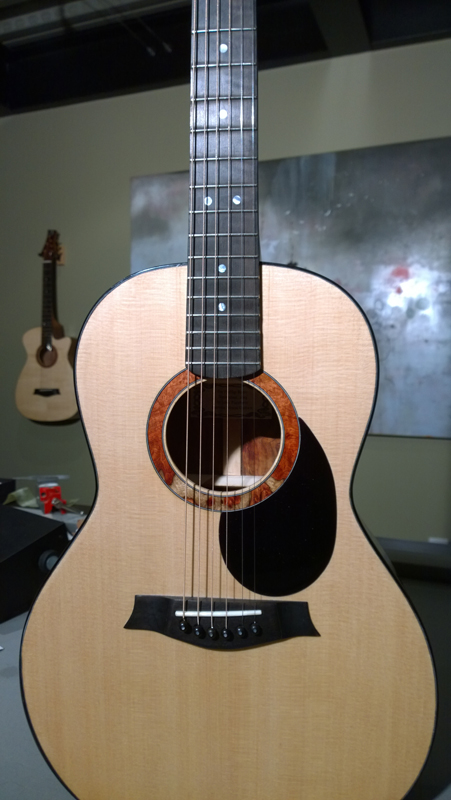
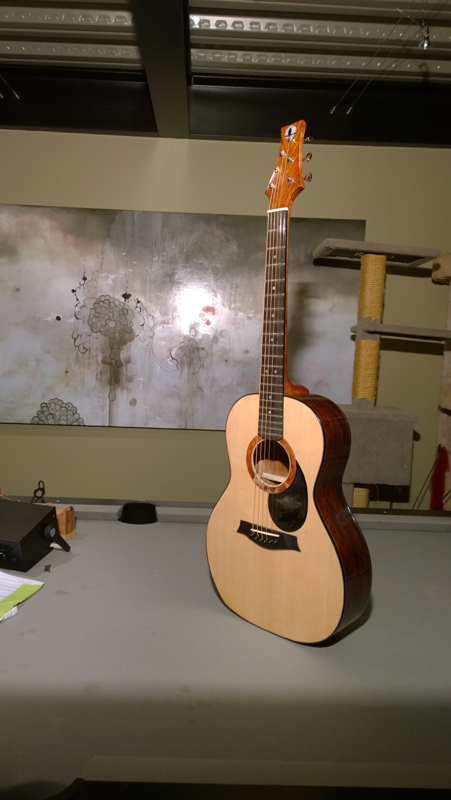
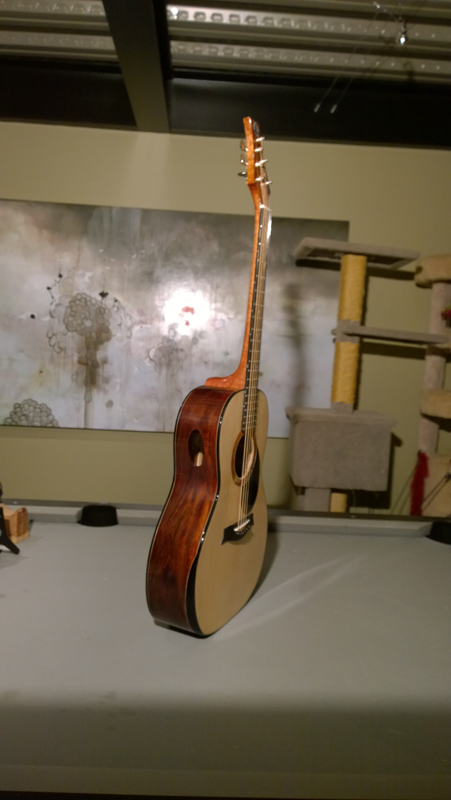
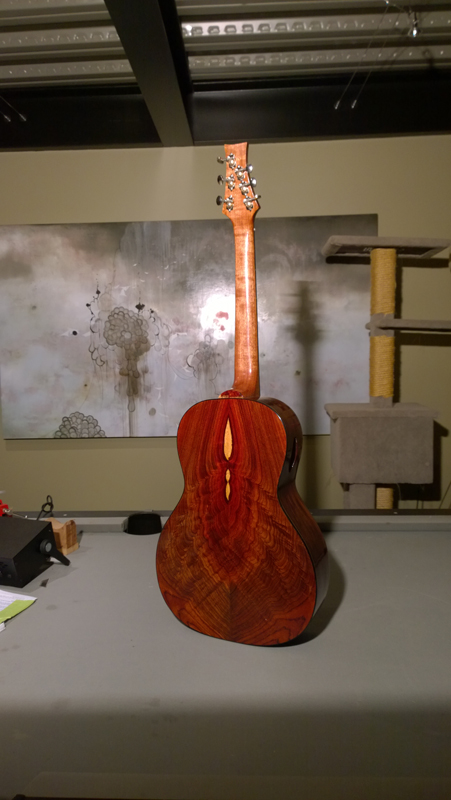
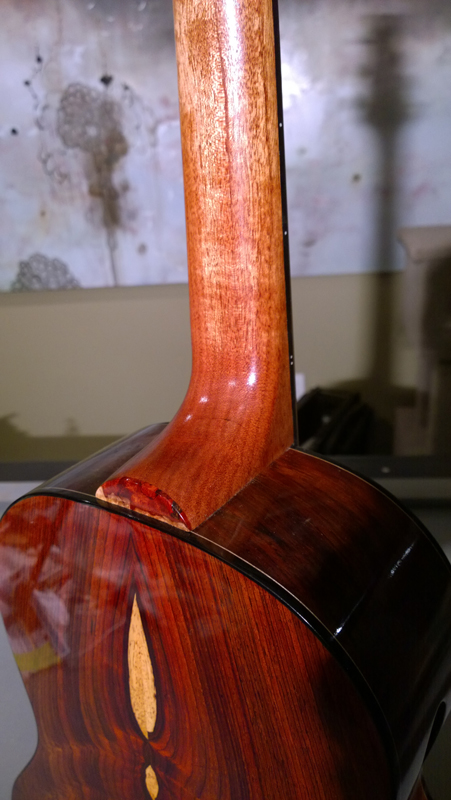
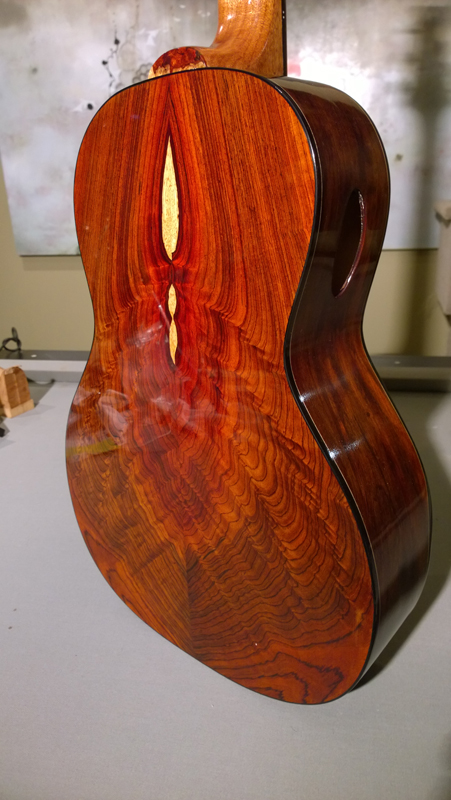
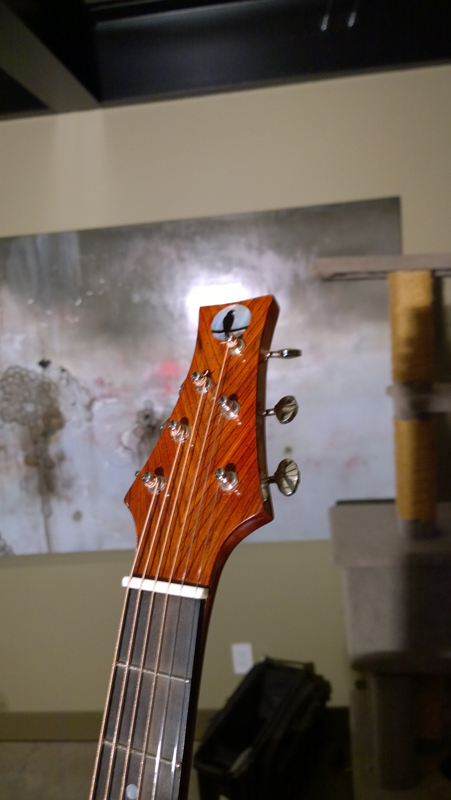
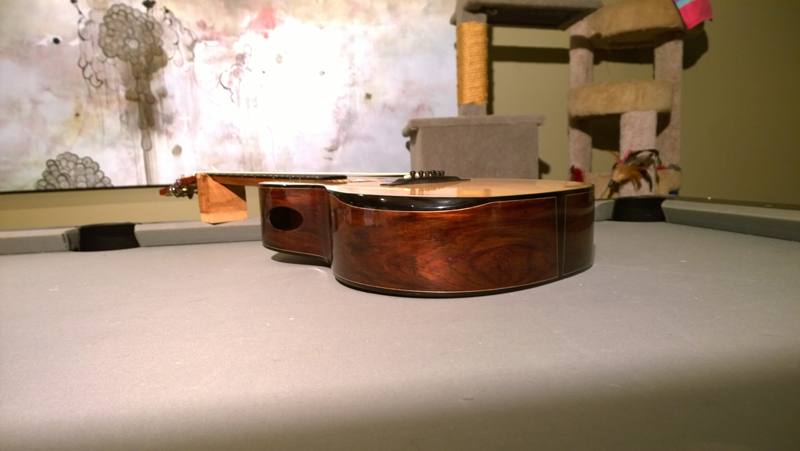
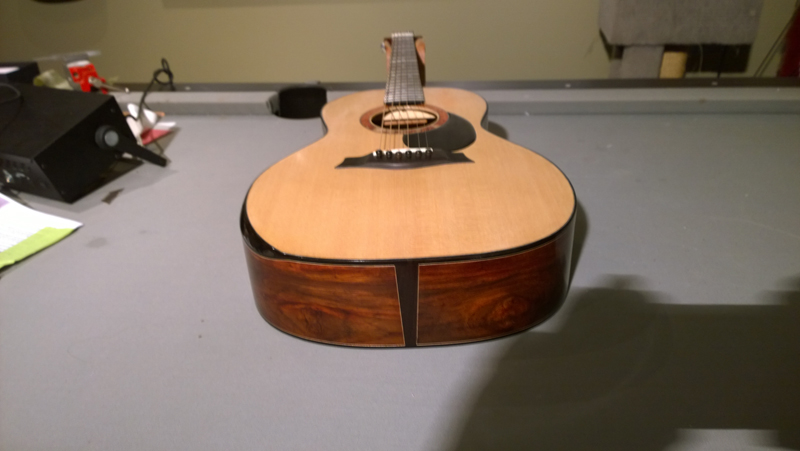
Top is Lutz Spruce
Back and sides - Cocobolo
rosette amboyna burl
fret board and bindings ebony
Short Scale









Re: Gallery of "Book" builds
Well, after the posts above displaying some stunning builds by professional and semi-professional guitar builders, here's one from a hobby builder. I started building electrics in about 2007 and only recently started building acoustics after buying the books. This post is about my second build, basically the falcate steel string from the plans in the book with some changes to the shape of the horn at the cutaway, to make the radius larger, and minor changes to the shape of the upper bout, hopefully to suit the changed horn. My first acoustic build was a 12 string and I'll post some pictures of that next.
Thanks to everyone on the forum who helped me. There are many that assisted through various threads, even if they do not know it.
Basic details:
Top : Engelmann Spruce
Back and Sides & headstock overlay: East Indian Rosewood
Neck : Honduran Mahogany
Fretboard : Ebony
Bracing : Sitka spruce (Carbon fibre reinforced)
Head and tail blocks : Queensland maple
Binding: Maple (ready made)
Purfling : Herringbone
Bridge : Wallnut (CF reinforced and ebonised. Linseed oil finish – thanks John Parchem for the tip)
Rosette : Cheap ready-made one from China. (I’ll make my own next time)
Nut & Saddle : Tusq
Pickups : K&K Pure mini
Finish : Nitrocellulose lacquer
Most of the wood came from Guitar Woods (Gilet). Thanks Daryl.
I did the Bolt-on Bolt-off neck and the carbon fibre laminated bridge, exactly as in the book. The curved braces in sitka spruce didn’t present any major problems for me during bending. I made the braces a tad shallower (6.8mm) because the sitka is stiffer than KW pine. I didn’t use carbon fibre reinforcing on the UTB or minor braces, only on the curved braces and the side braces (that is, only the braces that are highly stressed).
The only other departure from the method and sequence in the book is that I routed the mortice in the head block before gluing the block to the sides.
I did a fully compensated saddle but used a constant 1.2mm compensation at the nut. An additional benefit of using a 5mm thick compensated saddle is that you are not totally dependent on achieving perfect saddle placement. In placing the saddle, I ignored the 0.5mm shortening due to compression of the wood under string tension. When it came to measuring the string end position for the top E string on the saddle, it was 0.2mm from the front. Had I set the saddle back 0.5mm further, I would not have been able to achieve the correct length.
Here's some pictures. This post viewtopic.php?f=33&t=6706 is about measuring the resonant frequencies, monopole mobility and bridge rotation.
Thanks to everyone on the forum who helped me. There are many that assisted through various threads, even if they do not know it.
Basic details:
Top : Engelmann Spruce
Back and Sides & headstock overlay: East Indian Rosewood
Neck : Honduran Mahogany
Fretboard : Ebony
Bracing : Sitka spruce (Carbon fibre reinforced)
Head and tail blocks : Queensland maple
Binding: Maple (ready made)
Purfling : Herringbone
Bridge : Wallnut (CF reinforced and ebonised. Linseed oil finish – thanks John Parchem for the tip)
Rosette : Cheap ready-made one from China. (I’ll make my own next time)
Nut & Saddle : Tusq
Pickups : K&K Pure mini
Finish : Nitrocellulose lacquer
Most of the wood came from Guitar Woods (Gilet). Thanks Daryl.
I did the Bolt-on Bolt-off neck and the carbon fibre laminated bridge, exactly as in the book. The curved braces in sitka spruce didn’t present any major problems for me during bending. I made the braces a tad shallower (6.8mm) because the sitka is stiffer than KW pine. I didn’t use carbon fibre reinforcing on the UTB or minor braces, only on the curved braces and the side braces (that is, only the braces that are highly stressed).
The only other departure from the method and sequence in the book is that I routed the mortice in the head block before gluing the block to the sides.
I did a fully compensated saddle but used a constant 1.2mm compensation at the nut. An additional benefit of using a 5mm thick compensated saddle is that you are not totally dependent on achieving perfect saddle placement. In placing the saddle, I ignored the 0.5mm shortening due to compression of the wood under string tension. When it came to measuring the string end position for the top E string on the saddle, it was 0.2mm from the front. Had I set the saddle back 0.5mm further, I would not have been able to achieve the correct length.
Here's some pictures. This post viewtopic.php?f=33&t=6706 is about measuring the resonant frequencies, monopole mobility and bridge rotation.
Richard
Re: Gallery of "Book" builds
Here is the 12 string that was my first acoustic build. I started with plans of a Martin D12/28 from Ultimate Guitar Online but, after getting the books, I adapted the book plan of the J45 to the Martin body shape. The main change I made was to the top bracing. I made the X braces basically rectangular in section, 15mm high x 6.5mm wide and I made the sound hole braces and upper face braces a little taller.
Basic details:
Top : Sitka Spruce
Back and Sides & headstock overlay: Tasmanian Blackwood
Neck : Honduran Mahogany
Fretboard : Rosewood
Head and tail blocks : Queensland maple
Binding: Maple (ready made)
Bridge : Tasmanian Blackwood
Rosette : Cheap ready-made one from China.
Nut & Saddle : Tusq
Pickups : K&K Pure 12 String
Finish : Liberon Finishing Oil
I did the Bolt-on Bolt-off neck and I routed the mortice in the head block before gluing it in place. I did a fully compensated saddle and an almost fully compensated nut (used the same compensation for both strings in each pair).
Here's some pictures. This post viewtopic.php?f=33&t=6706 is about measuring the resonant frequencies and monopole mobility.
Basic details:
Top : Sitka Spruce
Back and Sides & headstock overlay: Tasmanian Blackwood
Neck : Honduran Mahogany
Fretboard : Rosewood
Head and tail blocks : Queensland maple
Binding: Maple (ready made)
Bridge : Tasmanian Blackwood
Rosette : Cheap ready-made one from China.
Nut & Saddle : Tusq
Pickups : K&K Pure 12 String
Finish : Liberon Finishing Oil
I did the Bolt-on Bolt-off neck and I routed the mortice in the head block before gluing it in place. I did a fully compensated saddle and an almost fully compensated nut (used the same compensation for both strings in each pair).
Here's some pictures. This post viewtopic.php?f=33&t=6706 is about measuring the resonant frequencies and monopole mobility.
Richard
- Trevor Gore
- Blackwood
- Posts: 1629
- Joined: Mon Jun 20, 2011 8:11 pm
Re: Gallery of "Book" builds
Nice work on both of them, Richard!
Fine classical and steel string guitars
Trevor Gore, Luthier. Australian hand made acoustic guitars, classical guitars; custom guitar design and build; guitar design instruction.
Trevor Gore, Luthier. Australian hand made acoustic guitars, classical guitars; custom guitar design and build; guitar design instruction.
-
johnparchem
- Blackwood
- Posts: 552
- Joined: Mon Jan 21, 2013 2:59 am
- Location: Seattle
- Contact:
Re: Gallery of "Book" builds
Ziricote\Spruce 12 string falcate.
I built this as a commission, although I told the client that it was an experimental build as it was my first 12 string. I did use a lot of information from the Gore\Gilet books including the bracing pattern and bolt on\off neck design. The body is the Gore medium size steel string. I followed a tutorial from Craig Lawrence for the 2 string per pin bridge. Richard Woods (Woodsy23) modified and ran an existing Finite Element (FE) model he had, for 12 strings load, both light and medium (EJ38s and EJ39s). He determined I would need to increase the height of the falcate braces to 10 mm for the EJ38s and 11 mm for the EJ39s. I ended up with 10.5 mm as I wanted to limit the monopole frequency of the top to keep it in the typical SS range. I ended with 175 Hz top frequency (that I may work to lower to 170 Hz). I have a spectrum analysis with strings at the bottom of this post. I did not measure the bridge rotation under load, but it looks good to my eyes.
My SS guitar instructor played it and the guitar sound great. I set up a recording session with him tomorrow and I will post it in my build thread.
The top is Lutz Spruce, back and sides Ziricote.
Bridge BRW, Fretboard EIR, Ebony bindings
rosette, Headstock, backstrap, end wedge, heel cap and side purfling are all Koa.
Finish: EM6000 on zpoxy fill for the body and CA fill and Royal Lac for the neck and head stock.

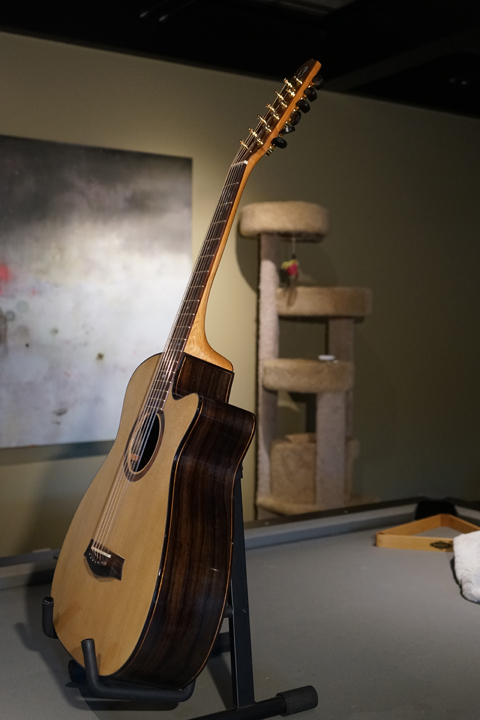
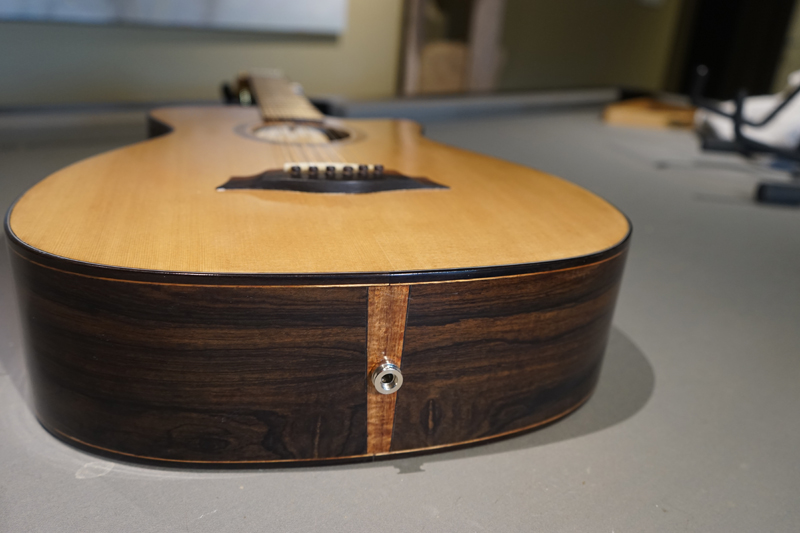
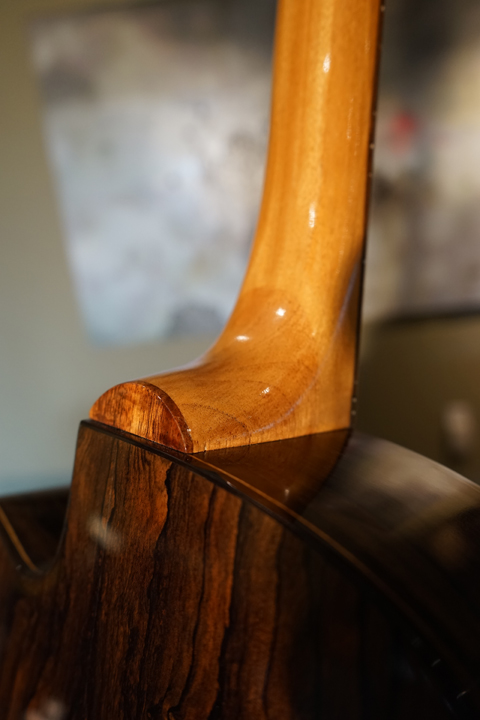

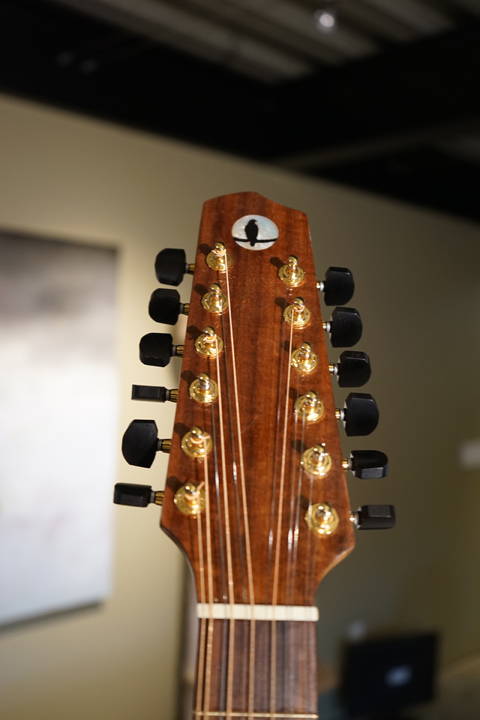
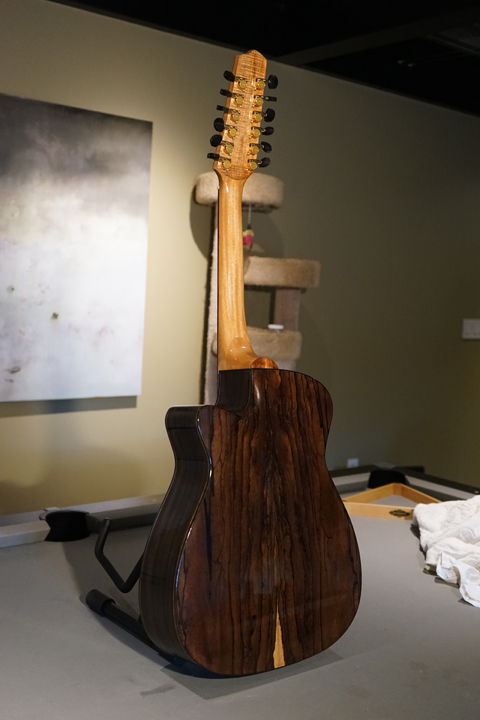
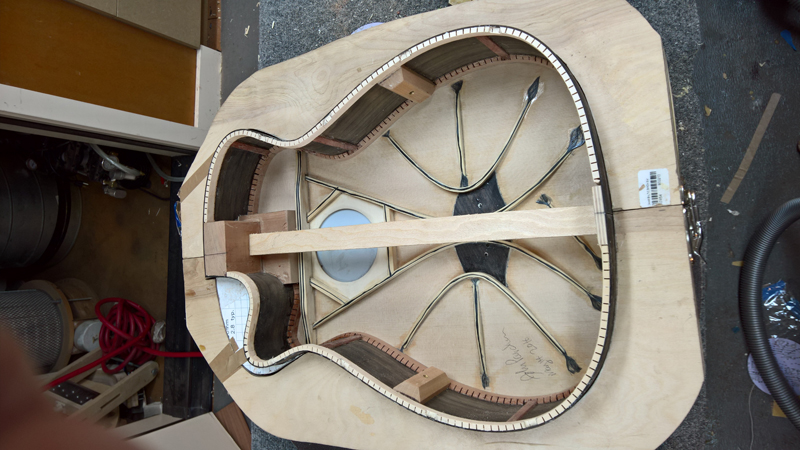
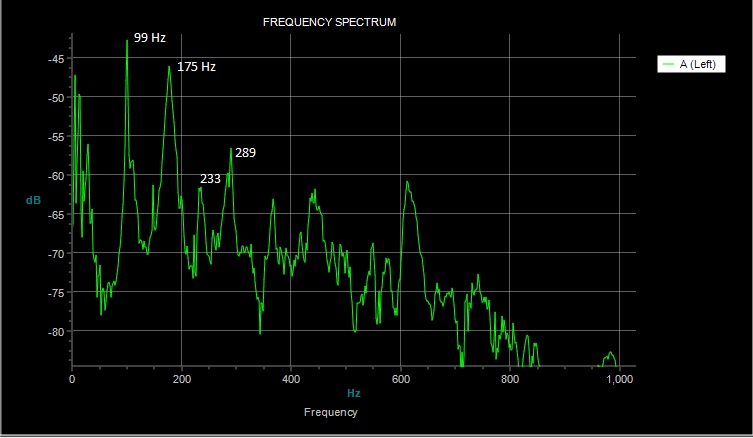
I built this as a commission, although I told the client that it was an experimental build as it was my first 12 string. I did use a lot of information from the Gore\Gilet books including the bracing pattern and bolt on\off neck design. The body is the Gore medium size steel string. I followed a tutorial from Craig Lawrence for the 2 string per pin bridge. Richard Woods (Woodsy23) modified and ran an existing Finite Element (FE) model he had, for 12 strings load, both light and medium (EJ38s and EJ39s). He determined I would need to increase the height of the falcate braces to 10 mm for the EJ38s and 11 mm for the EJ39s. I ended up with 10.5 mm as I wanted to limit the monopole frequency of the top to keep it in the typical SS range. I ended with 175 Hz top frequency (that I may work to lower to 170 Hz). I have a spectrum analysis with strings at the bottom of this post. I did not measure the bridge rotation under load, but it looks good to my eyes.
My SS guitar instructor played it and the guitar sound great. I set up a recording session with him tomorrow and I will post it in my build thread.
The top is Lutz Spruce, back and sides Ziricote.
Bridge BRW, Fretboard EIR, Ebony bindings
rosette, Headstock, backstrap, end wedge, heel cap and side purfling are all Koa.
Finish: EM6000 on zpoxy fill for the body and CA fill and Royal Lac for the neck and head stock.









- Trevor Gore
- Blackwood
- Posts: 1629
- Joined: Mon Jun 20, 2011 8:11 pm
Re: Gallery of "Book" builds
Here's another remarkable guitar from Leonhard Augenstein:
"Last year I had the chance to buy two sets of a beautiful and quite rare (it is under protection, as you surely know) yew from a local wood dealer.
I used one set for my B-model and showed that on a local guitar show. One of the visitors was so excited about that guitar that he asked me to make a 12-string out of the second set together with German Spruce. The neck is made from maple and African Makoré, the Bindings are Tasmanian Blackwood. Fretboard and my bridge design is made from Lemon wood.
He wanted to have a cutaway, a sound port, Inlays with specially cut opal (oriental opal) on four places, he wanted Schaller Da Vinci tuners (!!!) and also a bevel. After some discussion I could convince him to forget the bevel. Instead I proposed to make a quite heavy domed top and, linked to that, an elevated neck, to get a better sound out of the guitar.
After he agreed with all my proposals I built the shown guitar. I had the idea of a separate cutaway for quite a long time already since that would allow the player to play up to the 20th fret without any touch of the sides. My client liked the idea a lot and I made that cutaway (which is a true cutaway actually) out of African Macoré. In the beginning it was quite heavy, but with forming and shaping it the way it finally looks I came to exact the weight that keeps the guitar in perfect balance. It stand perfectly vertical on the little end pin for the L.R.Baggs Lyric!
When I started to work with the guitar, I had your book in mind and what you wrote and explained with the extra weight inside for a better balanced tone. My (a little strange) thinking was “why hide something that can improve a guitar”? What I have built is surely not exactly what you explain in your book. But the result shows me that it even works this way. Inside the sides I have glued two blocks to reinforce the side for the weight outside and the sound of the guitar (which is a modified Dreadnought actually) is exactly what my client expected. Well balanced, it is just played with 10-47 strings and with that it is pretty loud, basses are there but not as heavy as in a normal Dreadnought.
There were a lot of problems and challenges to master. The most difficult one for me were the inlays which had to be covered with epoxy to protect them and later brought to a bright shine. Also the neck with the heavy tuners, the way I connected it to the body to get a totally free play feeling was also very challenging. The strings are fixed pin less, the head is slotted “negative” to save weight and a lot more details that are different to standard guitars.
We have named the guitar “Taxus” which is the Latin word for yew".
"Last year I had the chance to buy two sets of a beautiful and quite rare (it is under protection, as you surely know) yew from a local wood dealer.
I used one set for my B-model and showed that on a local guitar show. One of the visitors was so excited about that guitar that he asked me to make a 12-string out of the second set together with German Spruce. The neck is made from maple and African Makoré, the Bindings are Tasmanian Blackwood. Fretboard and my bridge design is made from Lemon wood.
He wanted to have a cutaway, a sound port, Inlays with specially cut opal (oriental opal) on four places, he wanted Schaller Da Vinci tuners (!!!) and also a bevel. After some discussion I could convince him to forget the bevel. Instead I proposed to make a quite heavy domed top and, linked to that, an elevated neck, to get a better sound out of the guitar.
After he agreed with all my proposals I built the shown guitar. I had the idea of a separate cutaway for quite a long time already since that would allow the player to play up to the 20th fret without any touch of the sides. My client liked the idea a lot and I made that cutaway (which is a true cutaway actually) out of African Macoré. In the beginning it was quite heavy, but with forming and shaping it the way it finally looks I came to exact the weight that keeps the guitar in perfect balance. It stand perfectly vertical on the little end pin for the L.R.Baggs Lyric!
When I started to work with the guitar, I had your book in mind and what you wrote and explained with the extra weight inside for a better balanced tone. My (a little strange) thinking was “why hide something that can improve a guitar”? What I have built is surely not exactly what you explain in your book. But the result shows me that it even works this way. Inside the sides I have glued two blocks to reinforce the side for the weight outside and the sound of the guitar (which is a modified Dreadnought actually) is exactly what my client expected. Well balanced, it is just played with 10-47 strings and with that it is pretty loud, basses are there but not as heavy as in a normal Dreadnought.
There were a lot of problems and challenges to master. The most difficult one for me were the inlays which had to be covered with epoxy to protect them and later brought to a bright shine. Also the neck with the heavy tuners, the way I connected it to the body to get a totally free play feeling was also very challenging. The strings are fixed pin less, the head is slotted “negative” to save weight and a lot more details that are different to standard guitars.
We have named the guitar “Taxus” which is the Latin word for yew".
Last edited by kiwigeo on Fri Jan 05, 2018 3:20 pm, edited 1 time in total.
Reason: Corrected Trevor attrocious spelling
Reason: Corrected Trevor attrocious spelling
Fine classical and steel string guitars
Trevor Gore, Luthier. Australian hand made acoustic guitars, classical guitars; custom guitar design and build; guitar design instruction.
Trevor Gore, Luthier. Australian hand made acoustic guitars, classical guitars; custom guitar design and build; guitar design instruction.
Who is online
Users browsing this forum: No registered users and 2 guests